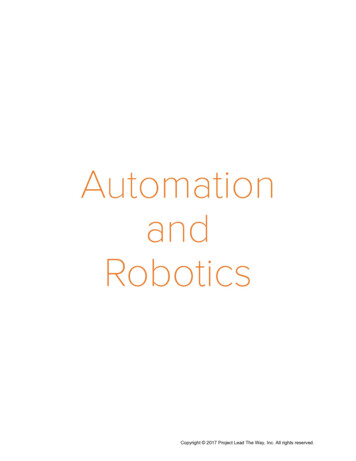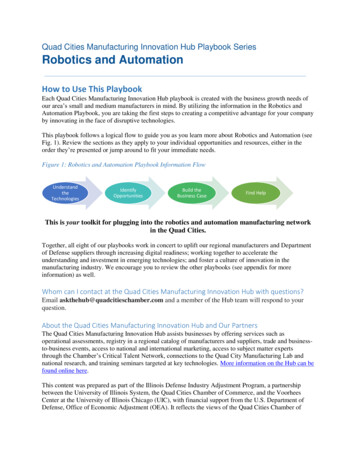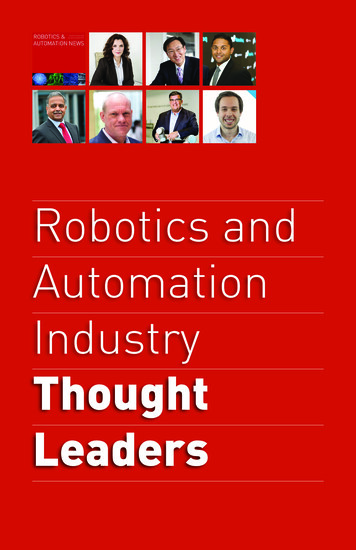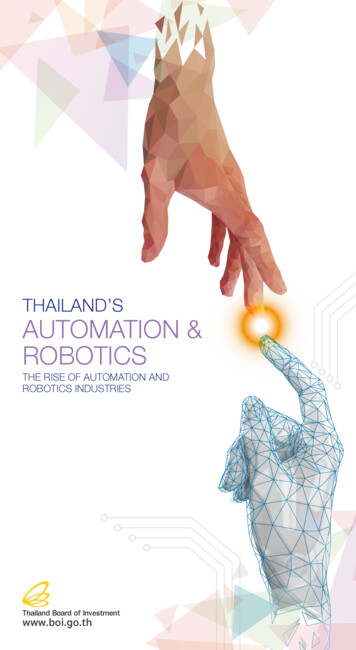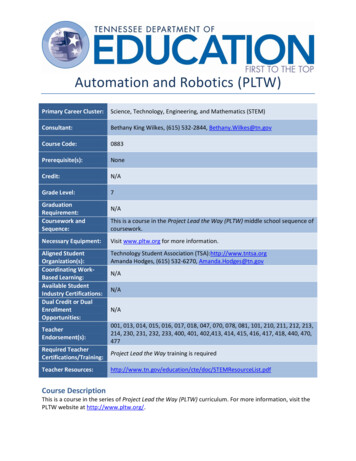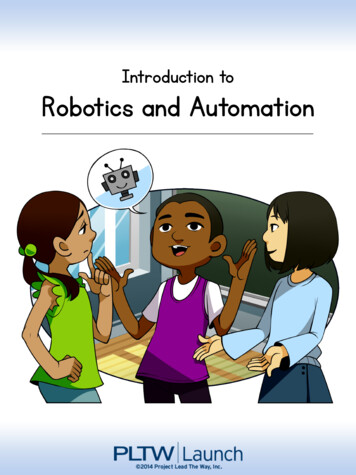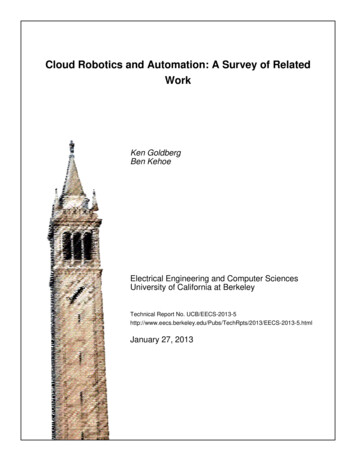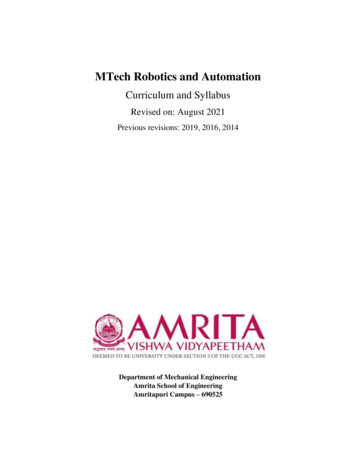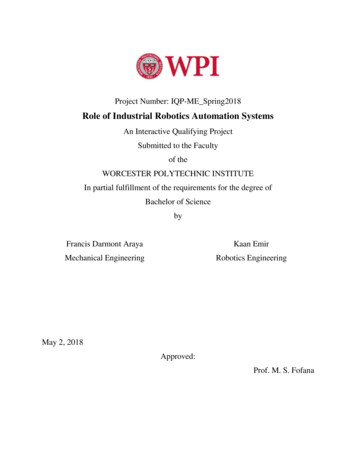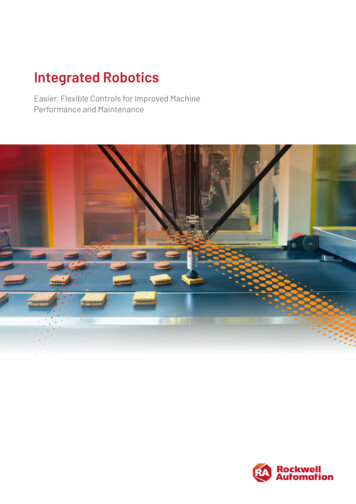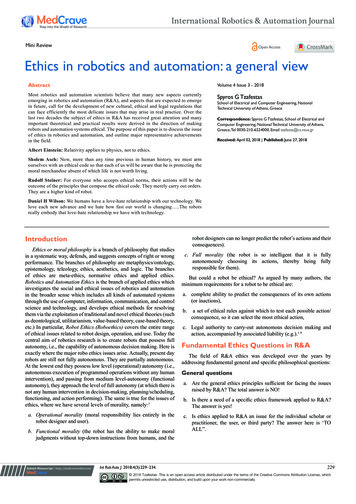
Transcription
International Robotics & Automation JournalMini ReviewOpen AccessEthics in robotics and automation: a general viewAbstractVolume 4 Issue 3 - 2018Most robotics and automation scientists believe that many new aspects currentlyemerging in robotics and automation (R&A), and aspects that are expected to emergein future, call for the development of new cultural, ethical and legal regulations thatcan face efficiently the most delicate issues that may arise in real practice. Over thelast two decades the subject of ethics in R&A has received great attention and manyimportant theoretical and practical results were derived in the direction of makingrobots and automation systems ethical. The purpose of this paper is to discuss the issueof ethics in robotics and automation, and outline major representative achievementsin the field.Spyros G TzafestasSchool of Electrical and Computer Engineering, NationalTechnical University of Athens, GreeceCorrespondence: Spyros G Tzafestas, School of Electrical andComputer Engineering, National Technical University of Athens,Greece, Tel 0030-210-6524000, Email tzafesta@cs.ntua.grReceived: April 02, 2018 Published: June 27, 2018Albert Einstein: Relativity applies to physics, not to ethics.Sholem Asch: Now, more than any time previous in human history, we must armourselves with an ethical code so that each of us will be aware that he is protecting themoral merchandise absent of which life is not worth living.Rudolf Steiner: For everyone who accepts ethical norms, their actions will be theoutcome of the principles that compose the ethical code. They merely carry out orders.They are a higher kind of robot.Daniel H Wilson: We humans have a love-hate relationship with our technology. Welove each new advance and we hate how fast our world is changing .The robotsreally embody that love-hate relationship we have with technology.IntroductionEthics or moral philosophy is a branch of philosophy that studiesin a systematic way, defends, and suggests concepts of right or wrongperformance. The branches of philosophy are metaphysics/ontology,epistemology, teleology, ethics, aesthetics, and logic. The branchesof ethics are meta-ethics, normative ethics and applied ethics.Robotics and Automation Ethics is the branch of applied ethics whichinvestigates the social and ethical issues of robotics and automationin the broader sense which includes all kinds of automated systemsthrough the use of computer, information, communication, and controlscience and technology, and develops ethical methods for resolvingthem via the exploitation of traditional and novel ethical theories (suchas deontological, utilitarianism, value-based theory, case-based theory,etc.) In particular, Robot Ethics (Roboethics) covers the entire rangeof ethical issues related to robot design, operation, and use. Today thecentral aim of robotics research is to create robots that possess fullautonomy, i.e., the capability of autonomous decision making. Here isexactly where the major robo ethics issues arise. Actually, present dayrobots are still not fully autonomous. They are partially autonomous.At the lowest end they possess low level (operational) autonomy (i.e.,autonomous execution of programmed operations without any humanintervention), and passing from medium level-autonomy (functionalautonomy), they approach the level of full autonomy (at which there isnot any human intervention in decision-making, planning/scheduling,functioning, and action performing). The same is true for the issues ofethics, where we have several levels of morality, namely:1a. Operational morality (moral responsibility lies entirely in therobot designer and user).b. Functional morality (the robot has the ability to make moraljudgments without top-down instructions from humans, and theSubmit Manuscript http://medcraveonline.comInt Rob Auto J. 2018;4(3):229‒234.robot designers can no longer predict the robot’s actions and theirconsequences).c. Full morality (the robot is so intelligent that it is fullyautonomously choosing its actions, thereby being fullyresponsible for them).But could a robot be ethical? As argued by many authors, theminimum requirements for a robot to be ethical are:a. complete ability to predict the consequences of its own actions(or inactions),b.a set of ethical rules against which to test each possible action/consequence, so it can select the most ethical action,c. Legal authority to carry-out autonomous decision making andaction, accompanied by associated liability (e.g.).1-9Fundamental Ethics Questions in R&AThe field of R&A ethics was developed over the years byaddressing fundamental general and specific philosophical questions:General questionsa. Are the general ethics principles sufficient for facing the issuesraised by R&A? The total answer is NO!b. Is there a need of a specific ethics framework applied to R&A?The answer is yes!c. Is ethics applied to R&A an issue for the individual scholar orpractitioner, the user, or third party? The answer here is ‘TOALL”.229 2018 Tzafestas. This is an open access article distributed under the terms of the Creative Commons Attribution License, whichpermits unrestricted use, distribution, and build upon your work non-commercially.
Copyright: 2018 TzafestasEthics in robotics and automation: a general viewSpecific questionsI. Can we act ethically through, or with, robots and automatedsystems? If yes, how?II. Can we design robots to act ethically? If yes, how? Or,could robots be truly moral agents?III. Can we explain the ethical relationships between humanand robots? If yes, how?IV. Is it ethical to create artificial moral agents (machines/robots, software agents, automated systems)?V. How far can we go in embodying ethics in robots andautomation?VI. What are the capabilities that a robot should have in order tobe characterized as a moral/ethical robot?VII. How people should treat robots, and how should robots treatpeople?VIII. Should robots have rights?IX. Should robots be considered as moral patients?X. Should moral/ethical robots and intelligent machines havenew legal status?XI. What role would robotics and automation have into our lifeof the future?XII. Which type of ethical codes is correct for robots andmachines?XIII. Who or what is responsible if a robot or other automatedsystem causes harm?XIV. Who is responsible for actions performed by human-robothybrid beings?XV. Is the need to embed autonomy in a robot contradictory withthe need to embed ethics to it?XVI. Are there any types of robot that should not be designed?Why?XVII. How do robots decide what the proper description of anaction is?230XXVI. How do robots decide what the proper description of anaction is?XXVII. If there are multiple rules, how do robots deal withconflicting rules?XXVIII. Are there any risks to create emotional bonds with robots?XXIX. How can ethics and law be jointly applied in robotics andautomation?XXX. How might society and ethics change with R&A?To formulate a sound framework, all the above questions/issuesshould be properly addressed.Short review of R&A ethicsThe literature of R&A ethics is very vast. Our aim here is to providea short review of some major contributions. The term robo ethics,for robot ethics, was firstly introduced by G. Veruggio in the FirstSymposium on Robo ethics held in San Remo, Italy (Jan/Feb. 2004),and the first ethical system in robotics was proposed by Asimov10,consisting of the so-called Asimov Laws. These deontological laws areanthropocentric (human-centered) in the sense that the role of robotsis to operate in the human service, and imply that robots have thecapability to make moral decisions in all cases. Roboethics concernsethics that occur with robots, such as whether robots pose a threatto humans in the long or short run, whether some uses of robots areproblematic, such as in healthcare or as killer robots of war, and howrobots should be designed such as they act ethically. Very broadly,scientists and engineers look at robotics in the following ways:11a. Robots are mere machines (surely, very useful and sophisticatedmachines).b. Robots raise intrinsic ethical concerns along different human andtechnological dimensions.c. Robots can be regarded as moral agents, not necessarily possessingfree will mental states, emotions, or responsibility.d. Robots can be conceived as moral patients, i.e., beings that can beacted for good or bad.Veruggio defines robo ethics as follows:XXII. Which type of ethical codes is correct for robots andautomated systems?“Roboethics is an applied ethics whose objective is to developscientific/cultural/technical tools that can be shared by different socialgroups and beliefs. These tools aim to promote and encourage thedevelopment of ‘ROBOTICS’ for the advancement of human societyand individuals, and to help preventing its misuse against humankind.”Actually, roboethics shares many ‘crucial’ areas with computer ethics,information ethics, communication technology ethics, automationethics, management ethics, and bioethics. Galvan2 argues that robotspossess an intrinsic moral dimension because technology is not anaddition to mankind, but provide a way to distinguish man fromanimals.XXIII. Who is responsible for actions performed by human-robothybrid beings?Veruggio and Operto5 points-out that the principal positions ofscientists and engineers about roboethics are:XXIV. Is the need to embed autonomy in a robot contradictory withthe need to embed ethics to it?Not interested in roboethics: These scholars argue that the actionof robot designers is purely technical and does not have an ethical orsocial responsibility.XVIII. If there are multiple rules, how do robots deal withconflicting rules?XIX. Are there any risks to create emotional bonds with robots?XX. Is it ethical to program robots to follow ethical codes?XXI. Is it ethical to create robotic nurses and soldiers?XXV. Are there any types of robot that should not be designed?Why?Interested in short-term ethical issues: These scholars advocate thatCitation: Tzafestas SG. Ethics in robotics and automation: a general view. Int Rob Auto J. 2018;4(3):229‒234. DOI: 10.15406/iratj.2018.04.00127
Copyright: 2018 TzafestasEthics in robotics and automation: a general viewcertain ethical and social values should be adhered by robot designersin terms of good or bad.Interested in long-term ethical issues: These scholars accept thatrobot designers have global and long-term moral responsibility (e.g.,digital divide between societies).Asaro4 describes how it is possible to make robots that act ethically,and how humans must act ethically and take the ethical responsibilityon their shoulders, and discusses the question whether robots can befully moral agents. Wallach10,12 describes the three typical approachesfor creating ethical machines and robots, and artificial moral agents(AMAs) in general. These approaches are:a. Top-down approach in which the desired rules/laws/principles ofethical behavior are prescribed and embedded in the robot system.b. Bottom-up approach in which the robot develops its moral behaviorthrough learning. This is analogous to how children learn morality(what is right or wrong) based on social context and experiencefrom their family and human environment.c. Mixed approach in which proper combinations of the top-downand bottom-up approaches are followed.The ethical concerns of robot use include the following:Loss of privacy (guidelines should be developed to guard againstrobot misuse, e.g., when drones and robots collecting data enter ourhome).Safety issues (when robots work closely with humans).Liabilty issues (with regard to who is responsible for errors orfaults/failures during robot operation).Lin, Abney and Bekey8 present a number of contributions byworld-wide researchers that address many of the questions listedabove. Three comprehensive books on ethics of machines, robots,and information are the following: Capurro R et al.13-15 Two importantbooks on the more general field of techno ethics are those of Galvan2and Tavani.16Branches of roboethicsThe branches of roboethics are:Medical roboethics or health care robotics ethicsThis branch refers to medicine and health care assisted byrobots.7,17,18 The initiation of medical ethics goes back to the work ofHippocrates who has formulated the well-known Hippocratic Oath,which requires a new physician to swear upon a number of healinggods that he will uphold a number of professional ethical standards.The fundamental ethical principles of medical roboethics involvefirst of all the principles of the Charter of Medical Professionalism,namely: Autonomy (The patients have the right to accept or refusetheir treatment). Beneficence (The doctor should act in the best interestof the patient). Non-maleficence (The practitioner should “first not todo harm”). Justice (The distribution of scarce health resources anddecision of who gets what treatment should be just.). Truthfulness(The patient should not be lied and deserves to know the whole truth).Dignity (The patient has the right to dignity).231Assistive roboethics/Ethics of assistive robotsAssistive robots constitute a class of service robots which isfocused on the enhancement of the mobility capabilities of impairedpeople (people with special needs: PwSN) so as to attain theirbest physical and/or social functional level, and have the ability ofindependent living.7 Assistive robots/devices include the following:a. Assistive robots for people with impaired upper limbs and hands.b. Assistive robots for people with impaired lower limbs(wheelchairs, walkers).c. Rehabilitation robots for upper limb or lower limb.d. Orthotic devices.e. Prosthetic devices.The issues of assistive roboethics have been a strong concern overthe years the evaluation of assistive robots can be made along threemain dimensions, namely: cost, risk, and benefit. Since these evaluationdimensions are contradictory we cannot get full points on all of themat the same time. Important guidelines for these analyses have beenprovided by World Health Organization (WHO) which has approvedan International Classification of Functioning, Disability and Health(ICF).19 A framework for the development of assistive robots usingICF, which includes the evaluation of assistive technologies in users’life is described.20 A full code of assistive technology was released in2012 by the USA Rehabilitation Engineering and Assistive TechnologySociety (RESNA),21 and another code by the Canadian Commissionon Rehabilitation Councelor Certification (CRCC) in 2002.22Social roboethics or ethics of social robotsSociorobots (social, socialized, socially assistive, sociallyinteractive robots) are assistive robot that is designed to enter themental and socialization space of humans. This can be achieved bydesigning appropriate high-performance human-robot interfaces: HRI(speech, haptic, visual). The basic features required for a robot to besocially assistive are:7,23.24a. Understand and interact with its environment.b. Exhibit social behavior (for assisting PwSN, the elderly, andchildren needing mental/socialization help).c. Focus its attention and communication on the user (in order tohelp the user achieve specific goals).A socially interactive robot possesses the following additionalcapabilities:23,24I.II.Express and/or perceive emotions.Communicate with high-level dialogue.III.Recognize other agents and learn their models.IV.Establish and/or sustain social connections.V.VI.VII.Use natural patterns (gestures, gaze, etc.).Present distinctive personality and character.Develop and/or learn social competence.Citation: Tzafestas SG. Ethics in robotics and automation: a general view. Int Rob Auto J. 2018;4(3):229‒234. DOI: 10.15406/iratj.2018.04.00127
Copyright: 2018 TzafestasEthics in robotics and automation: a general viewWell known examples of social robots are:AIBO: a robotic dog (dogbot) able to interact with humans and playwith a ball (SONY).KISMET: a human-like robotic head able to express emotions (MIT).KASPAR: a humanoid robot torso that can function as mediator ofhuman interaction with autistic children.24QRIO: a small entertainment humanoid (SONY).Automous car roboethicsAutonomous (self-driving, driverless) cars are on the way.Proponents of autonomous cars and other vehicles argue that withintwo or three decades autonomously driving cars will be so accuratethat will dominate in number human-driving cars.25,26 The specifics ofself-driving vary from manufacturer to manufacturer, but at the basiclevel cars use a set of cameras, lasers and sensors located around thevehicle for detecting obstacles, and through GPS (global positioningsystems) help them to move at a preset route. Currently there are carson the road that perform several driving tasks autonomously (withoutthe help of the human driver). Examples are: lane assist system to keepthe car on lane, cruise control system that speeds-up or slows downaccording to the speed of the car in front, and automatic emergencybraking for emergency stop to prevent collisions with pedestrians.SAE (Society of Automotive Engineers) International (www.sae.org/autodrive) has developed and released a new standard (J3016) for the“Taxonomy and definitions of terms related to on-road motor vehicleautomated driving systems”.War/military roboethicsMilitary robots, especially lethal autonomous robotic weapons, lieat the center of roboethics. Supporters of the use of war robots arguethat these robots have substantial advantages which include the savingof the lives of soldiers, and the conduct of war more ethically andeffectively than human soldiers who, under the influence of emotions,anger, fatigue, vengeance, etc., may over-react and overstep the lawsof war. The opponents of the use of autonomous killer robots arguethat weapon autonomy itself is the problem and not mere control ofautonomous weapons could ever be satisfactory. Their central beliefis that autonomous lethal robots must be entirely prohibited. Theethics of war attempts to resolve what is right or wrong, both for theindividual and the states or countries contributing to debates on publicpolicy, and ultimately leading to the establishment of codes of war.26,27The three dominating traditions (doctrines) in the ‘‘ethics of war andpeace are):28a. Realism (war is an inevitable process taking place in the anarchicalworld system).b. Pacifism or anti-warism (rejects war in favor of peace)c. Just war (just war theory specifies the conditions for judging ifit is just to go to war, and conditions for how the war should beconducted).The ethical and legal rules of conducting wars using roboticweapons, in addition to conventional weapons, includes at minimumall the rules of just war, but the use of semiautonomous/autonomousrobots add new rules for firing decision, discrimination of lawful fromunlawful targets, responsibility, and proportionality.27,28232Cyborg ethicsCyborg technology aims to design and study neuromotor prosthesesin order to store and reinstate lost function with replacement that isdifferent as little as possible from the real thing (a lost arm or hand,lost vision etc.).29 The word Cyborg stands for cybernetic organism,a term coined by Manfred Clynes and Nathan Kline.30 A cyborg isany living being that has both organic and mechanical/electrical partsthat either restore or enhance the organism’s functioning. People withthe most common technological implants such as prosthetic limbs,pacemakers, and cochlear/bionic ear implants, or people who receiveimplant organs developed from artificially cultured stem cells can beconsired to belong to this category. The first real cyborg was a ‘labrat’ at Rockland State Hospital in 1950 (New York). The principaladvantages of mixing organs with mechanical parts are for the humanhealth. For example:a. People with replaced parts of their body (hips, elbows, knees,wrists, arteries, etc.) can now be classified as Cyborg.b. Brain implants based on neuromorphic model of the brain and thenervous system help reverse the most devastating symptoms ofParkinson disease.Disadvantages of Cyborg include:a. Cyborgs do not heal body damage normally, but, instead, bodyparts are replaced. Replacing broken limbs and damaged armorplating can be expensive and time consuming.b. Cyborgs can think the surrounding world in multiple dimensions,whereas human beings are more restricted in that sense. Acomprehensive discussion of Cyborgs is given.31Automation technology ethics: Automation technology ethics isthe part of applied ethics and technology ethics (technoethics) whichstudies the application of ethics to processes and systems automatedin one or the other degree.36,32 Today, automation is achieved usingdigital computers technology, digital feedback control technology,information technology, and modern communication technology.Therefore the ethical issues of automation naturally overlapconsiderably with the ethical issues rising in all of these areas, andcan be studied in a unified way. As noted33 many people feel thatusing a computer to do something which is illegal or unethical issomehow not as “wrong” as other “real” criminal or unethical acts. Acrucial fact regarding the application of ethics and ethical standardsin information-based practice is that many professionals in this areado not belong to professional organizations, and many others do notbelong to any professional organization. Three fundamental questionsabout information and automation ethics addressed are:34-36a. What constitute substantive ethical issues and how can we learn orknow about ethics related to automation?b. Do we need better ethics for automation systems? What is thisbetter ethics?c. Does anticipatory ethics that studies ethical issues at the R&D andintroduction stage of a technology, via anticipation of possiblefuture equipment, applications, and social implications, help todetermine and develop a better automation ethics?Three principal information and service requirements inautomation systems are the following, and their achievement dependson ethical performance of engineers and professionals:Citation: Tzafestas SG. Ethics in robotics and automation: a general view. Int Rob Auto J. 2018;4(3):229‒234. DOI: 10.15406/iratj.2018.04.00127
Copyright: 2018 TzafestasEthics in robotics and automation: a general viewAccuracy: Information must be as more accurate as possible suchthat the conclusions or decisions based on it are correct. Today theinformation which is viable and being accessed is sufficiently accurate.Accessibility: Information must be accessible. Accessibility involvesthe right of accessing the required information, as well as truepayments of charges to access the information.Quality of service: In contrast to goods, services are intangibleand heterogeneous. Production and consumption of service areinseparable. Quality of service (QoS) is defined and evaluated bythe client, and is not evaluated only on the basis of outcomes but onprocessing delivery. The key requirements for QoS are:37a. Reliability (promised service should be performed dependably andaccurately).b. Competence (the company has the skill and knowledge to carryout the service).c. Responsiveness (readiness and willingness to provide the service).d. Access (service personnel easily approachable by customers).e. Courtesy (politeness and friendliness of service personnel).Other areas of ethical concern in R&A are:I.II.Criminal behavior.Ownership and copyright.III.Privacy and anonymity.IV.Autonomy.V.VI.Identity.Professional conduct.Automation can have positive and negative impacts for the people,the organizations, and the society in general.38 Basic questions relatedto R&A social impact are the following:a. How might R&A affect the everyday life of human societymembers?233the employment and society is provided.39 Ethics is overlapping withlaw but goes beyond it. Laws provide a minimum set of standards forobtaining a desired human behavior. Ethics often provides standardsthat exceed the legal minimum. Therefore, that which is legal is notalways ethical. For good human behavior and development bothlaw and ethics should be respected. Specifically, ethics and laws aredifferent in the manner that ethics tells what a person should do andlaws specify what a person must do. The law is universally accepted,and ethics is ideal human conduct agreed upon by most of the people.The best results are obtained if the law and ethics go side by side so asto guide to actions that are both legal and ethical.40,41ConclusionThis paper has provided a short conceptual review of the ethicalaspects and social implications of R&A. The material presented startswith the fundamental phisophical questions about R&A ethics whichhave been addressed in the literature and still provide motivationfor further research. Then, the core of the paper is presented whichincludes:a. the review of R&A ethics,b. an outline of the major branches of roboethics (medical robot,assistive robot, social robot, autonomous cars, war/military robot,cyborg ethics), andc. a discussion of automation technology ethics and socialimplications. Extensive coverage of the concepts, and topicsreviewed in the paper is provided in the references cited. A globalconclusion is that there is still a strong need to develop morepractical, and easy to understand and apply, ethical rules and codesfor the designers, professionals, and users of R&A products.AcknowledgementsMy Institute’s (National Technical University of Athens)representative needs not to be fully aware of this submission.Conflict of interestThe author declares there is no conflict of interest.b. Could vulnerable people be particularly affected by R&A?Referencesc. Could events occurring in the virtual world of R&A have negativeimpact on the real world?1. Wallach W, Allen C. Moral machines: Teaching robots right from wrong.Oxford, UK: Oxford University Press; 2009.d. Does R&A seek informed consent where necessary?2. Galvan JM. On technoethics. IEEE Robotics and Automation Magazine;2003;10:58–63.From a technical point of view, robotic automation implies a rangeof technical advantages and disadvantages, namely:Advantages: Reliability, Sensitivity, Endurance, Motion velocity,Mechanical power, Work accuracy.Disadvantages: Human isolation feeling, Telepresence and virtualreality.The interaction between automated systems and robots withpeople brings about new legal considerations in respect to safety andhealth regulations, law compliance, and assignment/apportioningof risk and liability. Those using robotic production lines that relyheavily on multiple technologies should ensure that they havecontractual arrangements agreed with each machine or technologysupplier. A thorough discussion of the implications of robotics on3. Veruggio G. The birth of roboethics. Proceedings of ICRA’2005: IEEEInternational Conference on Robotics and Automation: Workshop onRoboethics; 2005 Apr 18; Barcelona, Spain. 2005. p. 1–4.4. Asaro PM. What should we want from a robot ethic? International Reviewof Information Ethics. 2006;6(12):10–16.5. Veruggio G, Operto F. Roboethics: A bottom-up interdisciplinarydiscourse in the field of applied ethics in robotics. International Review ofInformation Ethics. 2006;6(12):3–8.6. Ramaswany S, Joshi H. Automation and ethics. Handbook of Automation,Berlin: Springer; 2009: 809–833.7. Tzafestas SG. Roboethics: A Navigating Overview. Intelligent Systems,Control and Automation: Science and Engineering, Springer; 2016.Citation: Tzafestas SG. Ethics in robotics and automation: a general view. Int Rob Auto J. 2018;4(3):229‒234. DOI: 10.15406/iratj.2018.04.00127
Copyright: 2018 TzafestasEthics in robotics and automation: a general view2348. Lin P, Abney K, Bekey GA. Robot Ethics: The ethical and socialimplications of robotics. MIT Press; Cambridge, MA, USA. 2012.26. Walzer M. Just and unjust wars: A moral argument historical withillustrations. New York. 2000.9. Lichocki P, Kahn PH, Billard A. The Ethical landscape of robotics. IEEERobotics and Automation Magazine. 2011;18(1):39–50.27. Coates AJ. The ethics of war. Manchester, UK: University of ManchesterPress; 1997:1–320.10. Asimov I. Runaround: Astounding science fiction, march 1942.Republished in robot visions, New York, USA: Penguin. 1991.28. Asaro A. Robots and responsibility from a legal perspective. Proceedingsof 2007 IEEE International Conference on Robotics and Automation:Workshop on Roboethics, Rome. 2007:1–13.11. Veruggio G, Solis J, Van der Loos M. Roboethics: ethics applied torobotics. IEEE Robotics and Automation Magazine. 2001;18(1):21–22.29. LynchW. Wilfred Implants: Reconstructing the Human Body. Journal ofClinical Engineering. 1982;7(3):1–263.12. Wallach W, Allen C, Smit I. Machine morality: Bottom-up and top-downapproaches for modeling moral faculties. AI Society. 2008;22(4):565–582.30. Clynes M, Kline S. Cyborgs and space. Astronautics; 1960.13. Capurro R, Nagenborg M. Ethics and robotics. Amsterdam, TheNetherland: IOS Press; 2009.31. Warwick K. Cyborg moral, cyborg values, cyborg ethics. Ethics andInformation Technology. 2003;5(3):131–137.14. Dekker M, Guttman M. Robo-and-Informationethics:Fundamentals. Muenster, Germany: LIT Verlag. 2012.32. Luppicini R. Technoethics and the evolving knowledge society: ethicalissues in technological design, research, development, and innovation.IGI Global; 2010:1–323.Some15. Gundel DJ. The Machine Question: Critical Perspectives on AI, Robots,and Ethics. Cambridge, MA, USA: MIT Press; 2012.16. Tavani HT. Ethics and technology: ethical issues in an age of informationand communication technology. New Jersey: John Wiley; 2004.17. Mappes TA, De Grazia D. Biomedical ethics. New York: McGraw-Hill.2006.33. Phukan S. IT ethics in the Internet Age: New dimensions. InformationScience. 2002:1249–1257.34. Kendall KE. The significance of information systems research onemerging technologies: Seven information technologies that promise toimprove managerial eff
Apr 02, 2018 · Robotics and Automation Ethics is the branch of applied ethics which investigates the social and ethical issues of robotics and automation in the broader sense which includes all kinds of automated systems through the use of computer, information, communication, and control science a

